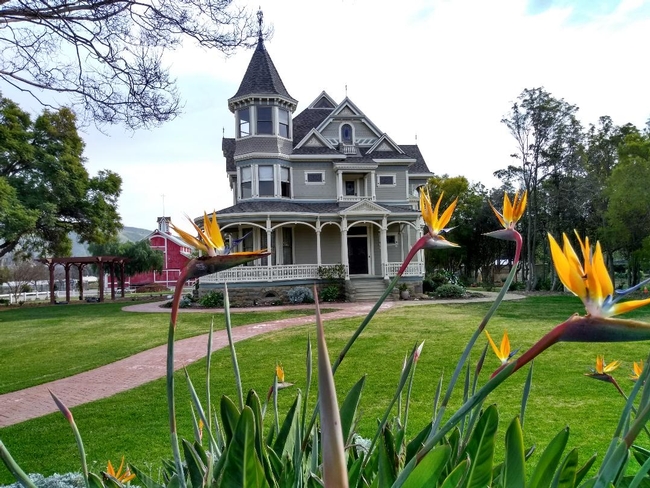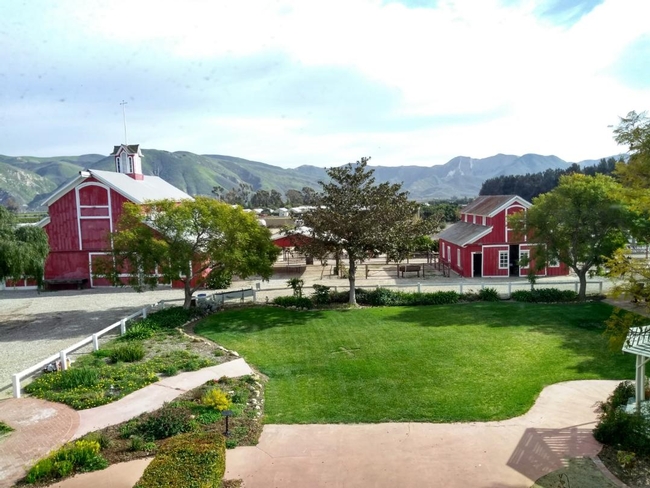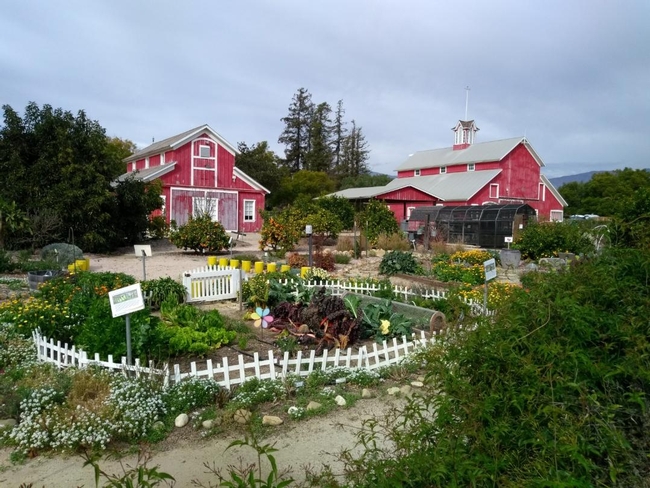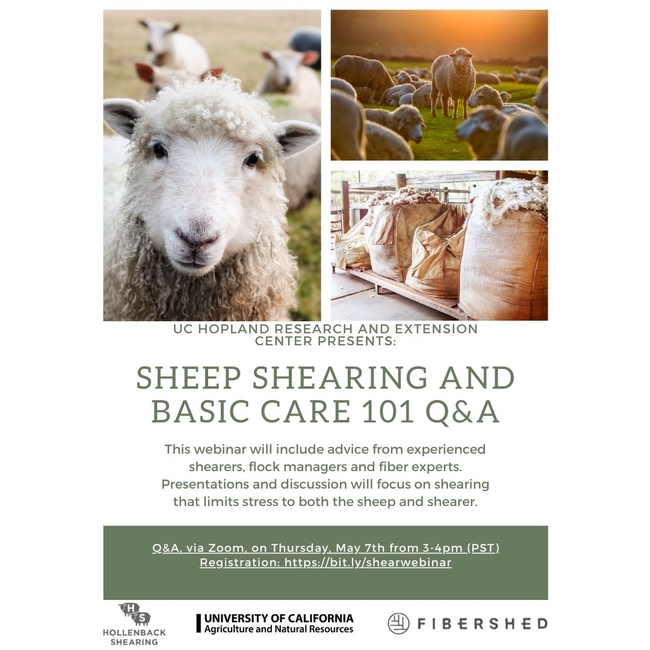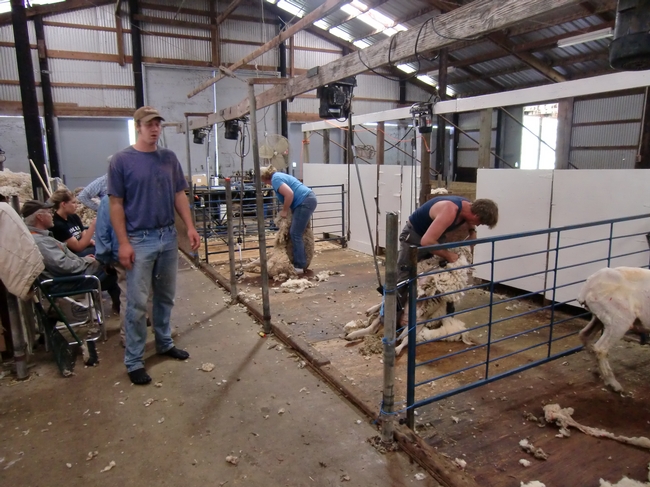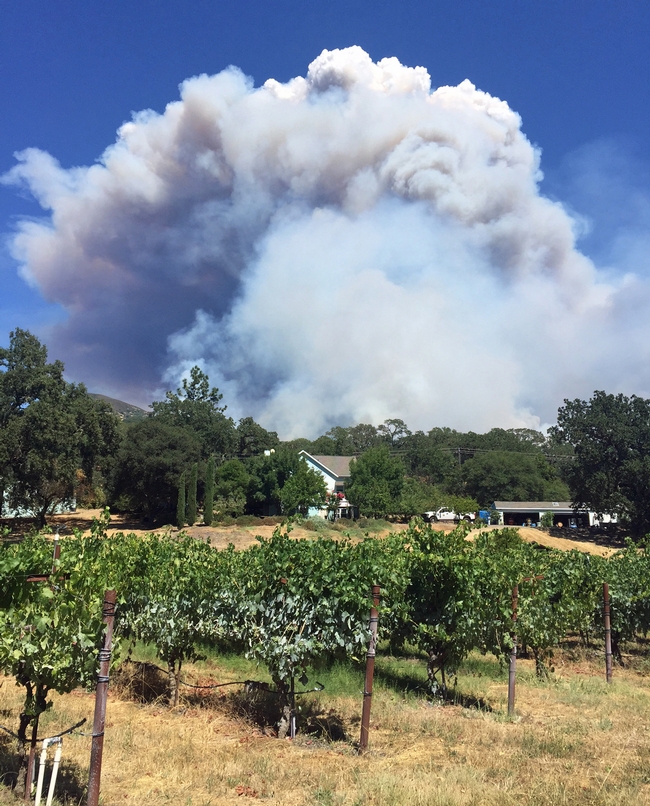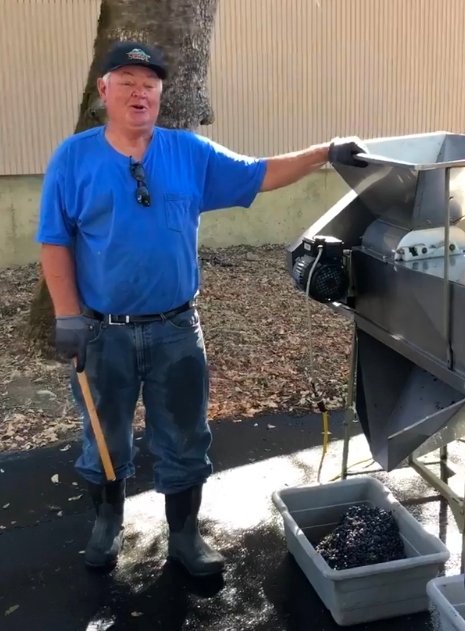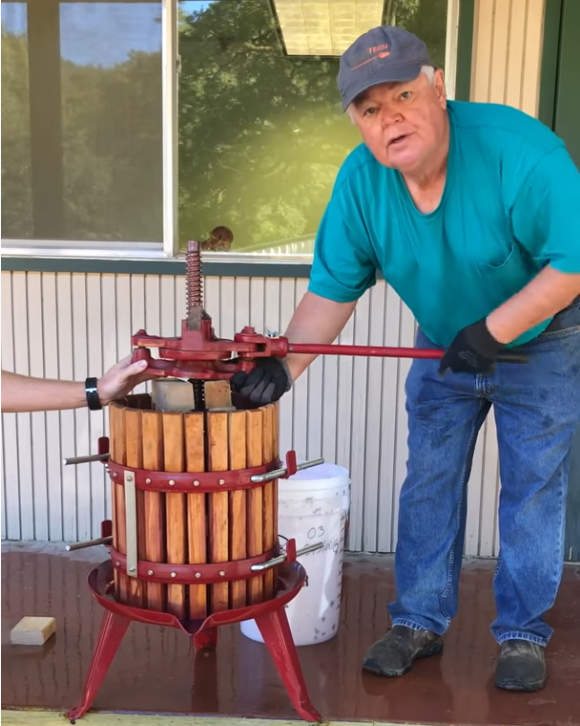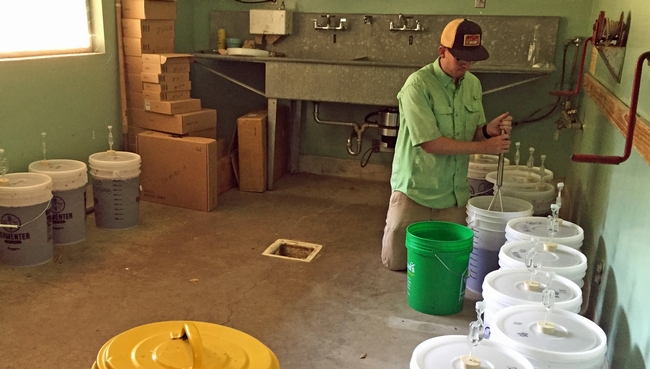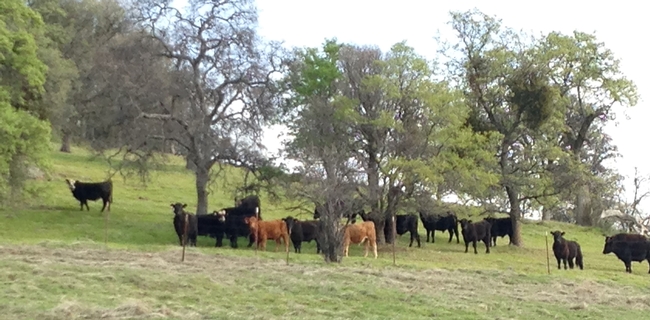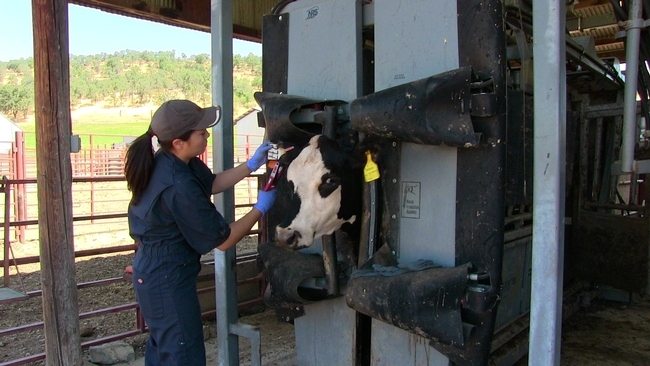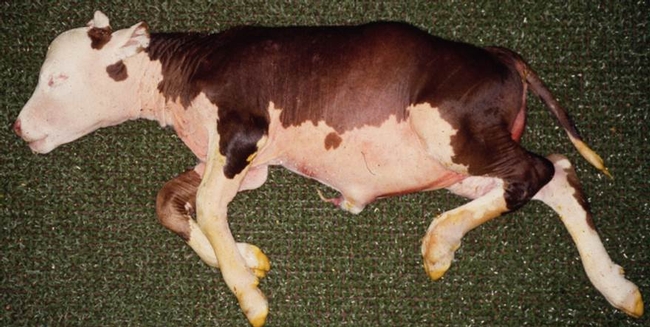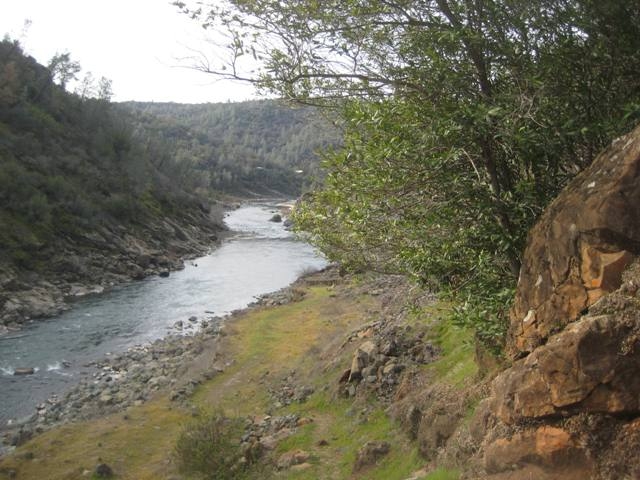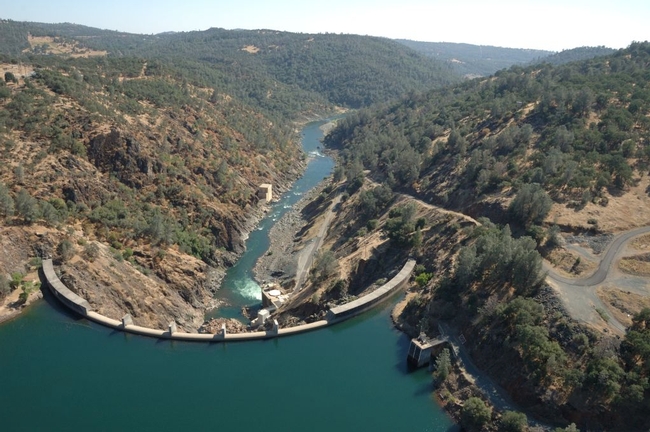Posts Tagged: Research and Extension Center
Faulkner Farm for sale as UCCE seeks larger research acreage in Ventura County
The historic Faulkner Farm, a 27-acre farm near Santa Paula, is for sale. The property, which houses the UC Hansen Agricultural Research and Extension Center, is listed at $3.7 million by the University of California Agriculture and Natural Resources.
The property on the corner of Telegraph Road and Briggs Road includes a 126-year-old Queen Anne Victorian house, a 134-year-old large red barn and a smaller barn built in 1982 for a Budweiser commercial. An orchard features an extensive collection of avocado varieties as well as a collection of tropical and sub-tropical trees including various citrus, banana, guava, mango, passion fruit, persimmon, papaya and fig.
UC acquired the Faulkner Farm in 1997, under the leadership of Larry Yee, who was director of Cooperative Extension in Ventura County at the time. The purchase was made with an endowment from Saticoy farmer Thelma Hansen, who passed away in 1993, for agricultural research and education activities in Ventura County.
Due to increasing maintenance costs for the historical buildings at Faulkner Farm and limited acreage for agricultural research, the Hansen Advisory Board along with agricultural stakeholders in the county recommended that UC ANR divest all or part of the property to honor the terms of the endowment. For over a decade, previous boards have recommended the sale to redirect the funds from maintenance of the historical landmark to support research and outreach for better fulfillment of the directives of the UC Cooperative Extension mission and enhance service to the Ventura County community.
“Now, more than ever before, we need to really expand our ability to find solutions for the challenges that agriculture faces: pests, diseases, climate change and more,” said Glenda Humiston, University of California vice president for agriculture and natural resources. “Enhancing research is critical to the future of agriculture for this region.”
The university will lease back a portion of the land for 18 months to complete active research projects and allow for continued UC Master Gardener Program activities at the site during the transition to the new location for its UC Hansen Agricultural Research and Extension Center.
“We are committed to having a UC Research and Extension Center in Ventura County, with more acreage to facilitate research on a wider range of crops and cropping systems, and better facilities for research and education,” said Mark Lagrimini, UC ANR vice provost of research and extension.
UC ANR is currently seeking a new location in the county.
“We are looking for 40 to 70 acres on the Oxnard Plain, ideally near potential partners and collaborators and suited for row and permanent crops,” said Annemiek Schilder, director of UC Cooperative Extension in Ventura County and the Hansen Agricultural Research and Extension Center.
“I am greatly saddened to learn that the University of California has decided to sell the Faulkner Farm, site of the Hansen Agricultural Center,” said Yee, the former director of UCCE in Ventura County and UCCE advisor emeritus. “In the beginning, we had every hope that the center would grow and prosper and serve both the needs of the agricultural and larger communities well into the future.”
Research at the facility focuses on improving crop productivity, irrigation, biocontrol of pathogens and pests, novel pruning techniques, and the introduction and evaluation of promising crop commodities. Additional research activities focus on issues in small-scale urban agriculture and organic farming.
UCCE advisors extend research results to local growers during field days and workshops at the site. Master Gardener volunteers maintain a demonstration garden, where they offer workshops for community members. Year-round 4-H agricultural literacy programs for students in grades K-12 include farm field trips, classroom outreach, an after-school Student Farm, and a Sustainable You! Summer Camp. The students learn about Ventura County agriculture, nutrition, cooking and sustainability.
“The Faulkner Farm has been such an important landmark and has made invaluable contributions to the life and well-being of the community,” Yee said. “Countless families, school children, teachers, Master Gardeners, researchers and other scientists have passed through its gates to enjoy learning about the importance of agriculture, how things grow and all the interrelationships between healthy soil, food and humans.”
Sales of property owned by the Regents of the University of California are governed by The Stull Act, which requires a sealed bid process. Bids are scheduled to be opened and reviewed in mid-November by the university.
Webinar: Sheep shearing and basic care 101
The University of California Hopland Research and Extension Center (HREC) will offer a sheep shearing and basic care Q&A via Zoom from 3 to 4 p.m. May 7. The session will include advice from experienced shearers, flock managers and fiber experts.
Presentations and discussion will focus on shearing that limits stress to both the sheep and shearer. We also encourage your questions regarding sheep handling, husbandry, flock health, running a mobile shearing service, ethical shearing, grazing for fuel reduction and climate beneficial ranching practices. This webinar will take the place of the planned Sheep Shearing and Basic Care 101 immersive workshop planned at HREC in Spring 2020.
Participants in the webinar may also be interested in learning more about the class planned for 2021. Due to these unprecedented times, you do not have to have been registered for the Sheep Shearing 101 class to attend this Q&A session.
The session is free, but registration is required. Click here to register for the webinar and to share your questions.
Speakers:
Ruthie King
King is a shepherd focused on intensive rotational grazing for soil building, ecosystem restoration, fuel reduction and nutrient/water cycling. She raises Icelandic and Targhee sheep and sells meat, wool, and pelts through direct marketing. Services she offers include sheep shearing and contract grazing.
Alison Smith
Smith is the shepherd of the flock of over 200 sheep at the UC Hopland Research and Extension Center. She also supports research and extension at the site.
Trevor Hollenback
Owner/operator of Hollenback Shearing, Hollenback has been professionally trained and employed as a shearer in the United States, New Zealand, Australia, and Austria. His primary focus in shearing is limiting stress to both the sheep and shearer.
Rebecca Burgess
Burgess is the executive director of Fibershed, chair of the board for Carbon Cycle Institute, and the author of “Harvesting Color.” A vocationally trained weaver and natural dyer, she creates hands-on curricula that focus on restoration ecology and fiber systems. Burgess has built an extensive network of farmers and artisans in the Northern California Fibershed to pilot an innovative fiber systems model at the community scale.
Where there is fire, is there smoke flavor in winegrapes?
UPDATED: Viticultural area is Kelsey Bench, not Kelseyville Bench.
UC Cooperative Extension study shows smoke damage to grapes not uniform across vineyards
By the time the Mendocino Complex Fires were officially contained on Oct. 4, 2018, five weeks after igniting, they had burned approximately 450,000 acres in Colusa, Lake, Glenn and Mendocino counties, making it the largest wildfire in California history, according to CalFire.
The fire not only destroyed 280 homes and other buildings, its smoke destroyed the market for wine grapes grown in vineyards near burned areas.
Fearing grapes near the fire would impart smoke flavors to the wine, some wineries rejected all fruit from nearby regions of Lake County and Potter Valley, leaving grape growers to hastily find new destinations for their 2018 crop.
“It can be difficult to determine if fruit has been compromised in quality when exposed to wildfire smoke, and whether or not smoke flavors will result in wine when fermented,” said Glenn McGourty, UC Cooperative Extension advisor in Mendocino County.
A new UC Cooperative Extension study shows wind direction and speed, temperature and a vineyard's proximity to an active fire are factors that can help growers and winemakers predict smoke damage to fruit.
“Fruit in my own vineyard, 60 feet across the street from where the fire started, had no smoke damage because the wind was blowing away from it,” McGourty said.
$41 million hit to wine grape sales
Due to the Mendocino Complex Fires, an estimated $41 million worth of winegrapes, which would have been sold at full price, were impacted – some were sold at a discount, some were sold to other customers, some were custom crushed, while some were left hanging in the vineyard, according to the Lake County Winegrape Commission and Mendocino County Farm Bureau.
The wine industry needed a scientific method of determining whether grapes could be made into a wine untainted by smoke. With funding from the Lake County Winegrape Commission, McGourty formed a workgroup of local growers and winemakers with Anita Olberholster, UC Cooperative Extension enology specialist in the Department of Viticulture & Enology at UC Davis, to research when fruit quality has been compromised.
“The need for industry standards regarding the impact of wildland smoke on winegrapes and the resulting wines has become even more pressing over the past few years,” said Debra Sommerfield, president of the Lake County Winegrape Commission.
Science showed the intensity, duration and timing of the exposure to wildfire smoke affects the grape's uptake. Generally, the closer to harvest, the greater risk to the fruit.
“Both the fruit and wine samples in our study showed a wide range of volatile phenol and glycocide concentrations, indicating that smoke damage to fruit was not uniform across the vineyards sampled,” McGourty said.
Volatile phenols and glycosides create off-flavors
Fresh smoke contains volatile phenols and glycosides that can affect fruit, but these chemicals tend to dissipate in the atmosphere in 1 to 2 hours. Vineyards close to actively burning fires and in the path of fresh smoke are most likely to be affected by smoke taint. Smoke that travels long distances is less likely to affect grapes and the wine made from the fruit.
The combination of volatile phenols and glycosides create “smoke taint” – both aromatic and tactile in the mouth. Wine drinkers may smell smoke or other off flavors and experience a drying of their mouth when high concentrations of the chemicals are present in wine.
“At lower concentrations, smoke taint reminds you of brett-affected wines,” Oberholster explained, referring to the yeast brettanomyces. “There is a shortness of fruit, a kind of dryness in the mouth that you know isn't normal. There may be barely perceptible aromas that aren't normal as well.”
Following wildfire smoke exposure, the researchers sampled fruit from 14 cabernet sauvignon vineyards around the viticultural areas of Lake County, including Upper Lake, High Valley, Big Valley, Kelsey Bench, Red Hills, Lower Lake and Guenoc Valley. As a control, fruit was also sampled from a Napa Valley vineyard that was not exposed to wildfire smoke.
“The volatile phenols guaiacol and 4-methyl guaiacol are detected in the fruit by gas chromatography, so it is possible to sample fruit before harvest to make picking decisions,” McGourty said. “Based on our study, berry sampling and guaiacol/ 4-methyl guaiacol analysis are useful for a quick evaluation of whether or not fruit from a particular vineyard may have the presence of volatile phenols that can potentially result in smoke-affected wine.”
Testing the fruit for volatile phenols and glycosides is both expensive and not completely predictive as standards are not well defined for damage based on smoke chemical concentration, he cautioned.
These two compounds aren't the only ones that cause smoke flavors. More than 70 other compounds in forest fire smoke can also produce undesirable flavors and odors described as “like licking an ash tray, burnt garbage, a burnt potato, a campfire that has been drenched with water.”
The taste test
To assess the levels of the compounds that produce the off-flavors, Oberholster convened a panel of 14 wine industry professionals to taste the sample wines. The wine tasters detected stronger off-flavors in the wines made from riper fruit, which also contained higher concentration of smoke compounds. Less than 6 micrograms per liter of the smoke compounds were difficult for the tasters to detect, leading the researchers to conclude they will have a minimal effect on wine quality.
Smoke from a distant fire
The scientists also looked at the influence of distance from the fire and elevation on smoke taint. They found some vineyards close to the edge of fires and immediately downwind were heavily affected, with the grapes containing high concentrations of the smoke flavor-causing compounds. But they determined elevation was not a factor in smoke flavors in wines.
Wind direction and speed, temperature and vineyard proximity to active fires are highly likely affect whether there will be smoke damage to the fruit, their research showed.
“Smoke generated in the first one or two hours from a wildfire is most damaging to nearby vineyards,” McGourty said. “Even though a vineyard may be enveloped in smoke, if the source of the smoke is from a distant fire, it will probably won't seriously damage the fruit quality because most of the volatile gases are gone.”
Lake County Winegrape Commission's Sommerfield said, “Today, the results of this study are already proving to be useful in deepening our understanding of smoke and the risks it poses to grapes and wine, in enabling grape growers and winery buyers to engage in fruitful discussions and make informed decisions, and, in turn, in helping to propel the development of industry standards and protocols.”
To read more about the study by McGourty, Michael I. Jones, Oberholster and Ryan Keiffer, see the January 2020 edition of Wine Business Monthly at https://www.winebusiness.com/wbm.
“This is a great little study, the first one that I know of that takes a systems approach to evaluating the effects of wildfire smoke,” said McGourty.
Glenn McGourty, UCCE viticulture advisor for Mendocino County, describes for Hannah Bird the UC project to analyze the effect of wildfire smoke on winegrapes.
To solve deadly cattle disease, ranchers collaborate with UC researchers at UC ANR research center
UC Sierra Foothill Research and Extension Center hosts cattle for research to commercialize vaccine
After more than 60 years of working closely with University of California Division of Agriculture and Natural Resources researchers to identify and learn how to manage a disease that causes the death of up to 90,000 calves annually, ranchers are optimistic that they are on the home stretch to getting a vaccine that will protect cattle.
Caused by tick-borne bacteria, the disease commonly known as foothill abortion is a leading cause of economic loss for California beef producers. To combat the disease, the California Cattlemen's Association is sponsoring UC vaccine trials, now in the second year, in commercial herds throughout California, Nevada and Oregon, which will facilitate commercial licensing of the product. At the same time, the UC researchers are continuing studies at the Sierra Foothill Research and Extension Center to identify the best time to vaccinate and potential side effects of the vaccine on the animals' health.
Through a 30-year partnership with the cattle industry, UC Davis veterinary immunologist Jeffrey Stott has been leading the effort to identify the organism causing the devastating disease and has successfully developed a live vaccine to protect cows against the disease.
“The vaccine is huge for the industry,” said Tom Talbot, Bishop beef producer and livestock veterinarian. “I don't think we fully understand the magnitude of the economic loss suffered from aborted calves.”
While Talbot was attending the School of Veterinary Medicine at UC Davis in the 1970s, his father purchased some cattle to breed in the mountains near Bakersfield. The following autumn, none of the calves from the Talbots' new heifers survived.
As an active member of the California Cattlemen's Association, Talbot has remained involved in the search for a cure.
While research trials demonstrated the vaccine was more than 95 percent effective in preventing the disease, UC researchers faced a major hurdle to making the vaccine commercially available to ranchers. USDA Center for Veterinary Biologics, which regulates animal vaccines, required detailed data on how the timing of vaccine delivery may impact embryo development following breeding.
“Gathering this information was not going to be easy, as it required applying careful experimental control on when animals were bred relative to when the vaccine was delivered and making frequent observations on a very large number of animals,” said Jeremy James, UC Sierra Foothill Research and Extension Center director.
The beef cattle industry and UC researchers realized that UC Agriculture and Natural Resources' 5,721-acre Sierra Foothill Research and Extension Center would provide an ideal outdoor laboratory for the critical research. The Pajaroellobacter abortibovis bacterium and pajaroello ticks that transmit the bacteria to cows naturally occur in the foothill pastures and the facility has a full-time, onsite staff to monitor the animals and collect the data.
“We're bringing together industry members and researchers in a research center framework in way that hasn't been done before for vaccine development,” said James.
The bacteria are endemic in California's coastal range and in the foothill regions of California, Southern Oregon and Northern Nevada.
Solano County-based Detar Livestock, which operates throughout California and part of Oregon, supplied 330 heifers for the experiment in 2014. Rancher Gabe Detar quickly recognized how this partnership might benefit industry across the state.
“They vaccinated half of them and there were zero abortions,” Detar said. “The cows without vaccinations had quite a few. It was a huge difference. The vaccine worked.”
This year Detar is contributing another 330 heifers. It takes 13 months to run an experiment because the vaccine has to be given to the heifer at least 60 days before she becomes pregnant, then it takes nine months until she gives birth to see if the calf survives.
In December, Stott and Myra Blanchard, a researcher with the UC Davis School of Veterinary Medicine, will begin inoculating cattle with the live vaccine for the disease, also known as epizootic bovine abortion.
The success of this research effort to defeat the cattle disease hinges on trust between the ranchers, UC scientists and the staff at the UC Sierra Foothill Research and Extension Center.
“The trust has to go in all directions,” James said. “The rancher has to trust that we'll take care of their animals because 300 cattle is a large investment. Likewise, the researchers have to trust the producers to supply the quantity and quality of animals they need to complete the work and for the staff at the Sierra Foothill Research and Extension Center to manage the animals exactly as required under their research protocols.”
Ranchers hope the vaccine will become commercially available soon to provide relief from foothill abortion disease. Until then, only the cattle participating in the research can receive the experimental vaccine.
“The disease can kill upwards of 60 to 70 percent of fetuses in infected cattle, which can jeopardize a cattle producer's business,” said Stott.
Funding for the study has been provided by the U.S. Department of Agriculture, the California Cattlemen's Association and a UC Proof of Concept Discovery Grant (grant ID no. 212263) from UC's Office of the President, with additional funding from the Russell L. Rustici Rangeland and Cattle Research Endowment and the UC School of Veterinary Medicine's Center for Food Animal Health.
For more information on how to manage cattle to prevent foothill abortion disease, visit http://anrcatalog.ucanr.edu/pdf/8566.pdf.
UC receives PG&E land to expand research in Sierra foothills
The parcel, which is adjacent to the UC Sierra Foothill Research and Extension Center in Browns Valley, will be managed by UC to protect its natural resources. Bear Yuba Land Trust will hold the conservation easement on the Narrows property to ensure that it remains permanently protected and available for public benefit. The transaction closed today (Jan. 29).
Located on the Yuba River, the Narrows property is 60 miles northeast of Sacramento. UC Sierra Foothill Research and Extension Center has more than 5,700 acres of rangeland for scientists to study critical rangeland issues.
“We are excited to be able to manage this parcel because this new property will increase the size and connectivity between key research pastures at Sierra Foothill Research and Extension Center,” said Jeremy James, Sierra Foothill Research and Extension Center director.
Cattle grazing is a major tool to manage vegetation on rangelands and to enhance rangeland ecosystems. Although the Narrows land is too steep for grazing, it can be used to study a suite of critical natural resource processes.
“This is the first of several land transfers from PG&E to a public agency in the Yuba River watershed and the only in Yuba County,” said Marty Coleman-Hunt, Bear Yuba Land Trust executive director. “It's the culmination of over a decade of planning and work with local conservation groups and the Stewardship Council. The permanent protection of this land below Englebright Dam is critical for the health of the important Yuba River salmon fishery and public recreation for the lower Yuba River.”
“In partnership with the many organizations that make up the Stewardship Council, PG&E is pleased to permanently protect the natural resources and beauty of the Narrows parcel and watershed lands associated with our hydroelectric system for the benefit of current and future generations,” said Mike Schonherr, manager of PG&E's Land Conservation Commitment Department.
The research center encompasses river, grassland, oak woodland and riparian habitat types for studying beef cattle production, nutrition and health, rangeland water quality management, oak woodland restoration, native plant conservation and invasive plant management as well as monitoring and management of sensitive fish and wildlife species.
The center has many educational features including a series of nature trails and an education center on the Yuba River, which can be used by schools and community groups for outdoor education and outreach events.
Bear Yuba Land Trust is a non-profit, membership-supported group that promotes voluntary conservation of natural, historical and agricultural resources in the Bear and Yuba watersheds of the Sierra Nevada foothills. Each year, BYLT's stewardship team will monitor the conservation easement at the Narrows for conservation values like documenting the presence of native plants and animals. BYLT will hold the development rights forever, meaning the land will be permanently protected as a natural place and remain undeveloped.
For more information about PG&E's transfer of the Narrows property, visit http://www.stewardshipcouncil.org/land_conservation/planning_units/narrows.htm.
For more information about the UC Sierra Foothill Research and Extension Center, please visit http://sfrec.ucanr.edu.
For more than 100 years, University of California Cooperative Extension researchers and educators have been drawing on local expertise to conduct agricultural, environmental, economic, youth development and nutrition research that helps California thrive. UC Cooperative Extension is part of the University of California's systemwide Division of Agriculture and Natural Resources. Learn more at ucanr.edu.

